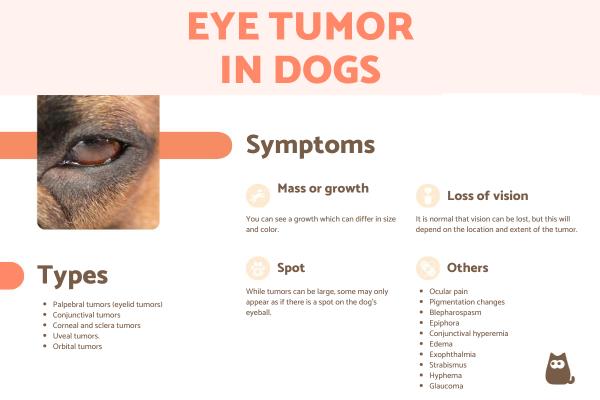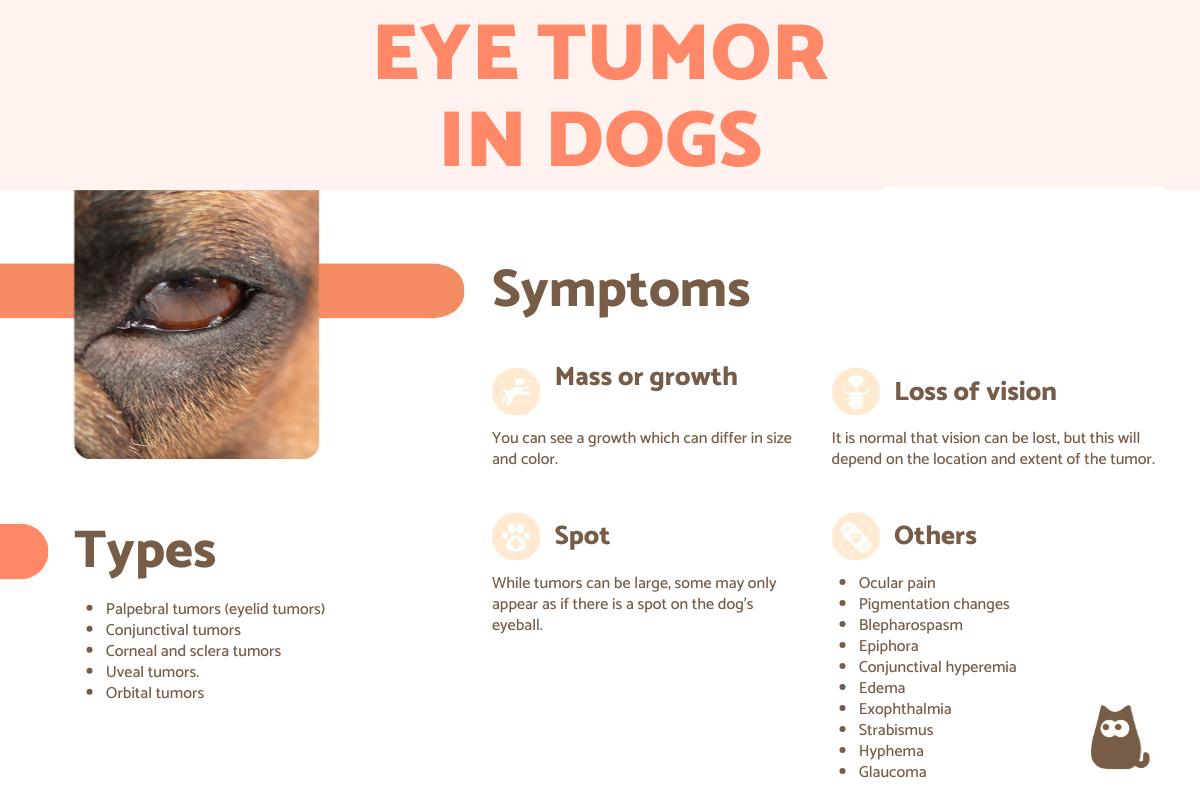Dog Eye Tumor Symptoms and Treatment



See files for Dogs
Ocular tumors are disorganized growths of cells that can occur in the different tissues and structures that make up the eye. Symptoms of eye tumors in dogs will depend on the affected tissues, with some complicating treatment more than others. The therapies required can be invasive, especially if the tumor is cancerous and metastasis has occurred. Early detection and the establishment of suitable treatment during early stages is the best way to ensure a good prognosis. In many cases, removal of the eye may be required.
At AnimalWised, we fin out specifics about dog eye tumor symptoms and treatment. We stress that it is a very serious problem which required veterinary diagnosis, so do not hesitate to go to a vet if you think your dog may have an ocular tumor.
Types of eye tumors in dogs
A tumor is a type of neoplasia, defined as the disorganized growth of cells that occurs as a result of a genetic mutation, as well as other factors such as exposure to carcinogens. Ocular tumors develop on the different structures that make up the eye. Among them, the following types of dog eye tumors can be found:
- Palpebral tumors (eyelid tumors): these are the most common ocular tumor in dogs. The most common among them are meibomian gland adenoma (a benign eyelid tumor) and meibomian gland adenocarcinoma (a malignant eyelid tumor). In addition to these, there are other tumors that can affect the eyelid of dogs, such as melanomas, histiocytomas, mastocytomas and papillomas.
- Conjunctival tumors: they have a greater tendency to malignancy and local infiltration than eyelid tumors, but their incidence is very low in dogs. Cases of melanomas, squamous cell carcinomas, mastocytomas, papillomas, hemangiomas, hemangiosarcomas, lymphosarcomas and histiocytomas have been described. Learn more about some of these abnormal growths with our article detailing skin tumors in dogs.
- Corneal and sclera tumors: these are also very rare in dogs. Papillomas are more common in young dogs, and squamous cell carcinoma, melanoma and papilloma are more common in adults.
- Uveal tumors: the uvea is a layer of the eye that is made up of the iris, ciliary bodies and choroid. The most common uveal tumor is melanoma, which appears as a spot inside the dog's eye.
- Orbital tumors: these are tumors that affect the tissue that forms the orbit in which the eyeball is housed. The most common are osteosarcomas, fibrosarcomas and nasal adenocarcinomas. Most orbital tumors in dogs are malignant and are not diagnosed until the disease is quite advanced.
Discover more about neoplasia in a different part of the body with our article investigating intestinal tumors in dogs.
Dog eye tumor symptoms
Ocular tumors in dogs can produce a wide variety of symptoms. The tumor itself can appear as a mass of variable size and color, but it can also appear as a a dark-colored spot. An example of the latter is an ocular melanoma in dogs.
The location and size of the tumor itself may cause associated symptoms. These can vary depending on the structure of the eye that is affected. Some of these symptoms may include:
- Loss of vision
- Eye pain
- Blepharospasm (abnormal blinking or eye closure)
- Pigmentation changes
- Epiphora (tearing)
- Conjunctival hyperemia (red eyes)
- Edema or inflammation of the conjunctiva
- Exophthalmia (eye bulging)
- Strabismus (improper alignment)
- Hyphema (blood in the anterior chamber of the eye)
- Glaucoma (increased intraocular pressure)
Eye bulging can be caused by the tumor itself. Even if it is benign, the size of the growth can push the eye outward and cause it to protrude from its position. Air coming in contact with the eye can cause secondary damage if it is unable to be properly lubricated.
Discover more about canine hyphema in our article on the causes of blood in a dog's eye.

Causes of dog eye tumors
As we have mentioned, a tumor is a disorganized growth of cells that can occur as a result of a genetic mutation, epigenetic changes or other changes to the cellular environment. Genetic mutations can be induced by different factors such as radiation, chemicals, hormones or exposure to carcinogens. In most cases, it has an idiopathic origin, meaning we will not know the direct cause.
In addition, some ocular tumors may be metastases. These are secondary tumors that originate from a primary tumor present elsewhere in the body. This is the case with transmissible venereal tumors, hemangiosarcoma or lymphosarcoma.
Diagnosis of dog eye tumor
The diagnosis of ocular tumor in dogs is based on the following procedures:
- Clinical diagnosis: through a complete ophthalmological examination that allows analysis of the appearance of the tumor and the symptoms it causes.
- Diagnostic imaging: including X-ray, ocular ultrasound or advanced imaging tests (such as CT or MRI).
- Histopathological diagnosis: by taking a tissue sample such as a cytology or biopsy which are analyzed microscopically. Histopathological analysis is the most effective diagnostic test, since it is the only one that allows us to know the exact origin of the tumor, its degree of malignancy and the invasive characteristics of the surrounding tissues.
If any malignant ocular tumor is detected, a complete examination of the animal should be performed to look for metastasis. This will include chest X-rays and abdominal ultrasound to see if the cancer has spread.
While it is possible the veterinary examination will result in a diagnosis of an eye tumor, there may be other causes of the symptoms shared above. Learn about the most common eye conditions in dogs which will help the vet to make a differential diagnosis.
Eye tumor in dogs treatment
Treatment of ocular tumors in dogs will need to take into account two main variables:
- Type of tumor: this will include its location, whether it is a localized or diffuse, whether there is metastasis in other organs and other factors. Depending on the above, surgical treatment, chemotherapy and/or radiotherapy may be considered.
- General condition of the animal: only stable patients will be able to undergo treatment, whether surgical or chemotherapy. A dog's overall health may determine whether treatment is therapeutic or palliative.
Below we mention some important aspects in the treatment of different types of ocular tumors:
- Eyelid tumors: although 75% of eyelid tumors are benign, most require surgery because they often disfigure the eyelid and irritate the animal's eye. Reducing the tumor volume with adjuvant cryotherapy may also provide good results.
- Conjunctival tumors: since they tend to be more malignant, they require more extensive surgery and generally adjuvant treatment such as cryotherapy, diode laser therapy, CO2 laser therapy or radiotherapy. In addition, periodic check-ups are required since they may recur.
- Corneal and sclera tumors: surgical removal or laser photocoagulation are usually effective, although in cases where the tumor extends within the eye, enucleation (removal of the entire eyeball) is necessary.
- Uveal tumors: depending on the size and location of the lesion, laser photocoagulation treatment, surgical removal or, in more severe cases, enucleation may be chosen.
- Orbital tumors: since these are mostly malignant tumors, the both the orbital tumor and the eyeball must be removed. Surgery combined with chemotherapy and/or radiotherapy can improve the animal's prognosis.
Learn about what palliative care for dogs with our article on what happens when my dog is dying.
How much does eye surgery for dogs cost?
In the United States, the cost of surgery for eye tumors in dogs can vary based on the procedure's complexity, the location and the veterinarian's expertise. Generally speaking, this type of surgery ranges between $1,000 and $3,000. Factors that affect price include the size and location of the tumor, the surgical technique used, anesthesia, pre- and post-operative care, and the region where the surgery is performed, as urban areas often have higher veterinary costs.
Most eye tumor surgeries for pets require a veterinary ophthalmologist to ensure the procedure’s success. The involvement of a specialist is necessary for the use of magnification equipment, microsurgical instruments and other specific materials that are essential for delicate eye procedures.

Can a dog survive eye cancer?
This question does not have a single answer. The life expectancy of a dog with an ocular tumor will depend on multiple factors, including the type of tumor, its location, its degree of malignancy, its tendency to metastasize, the general condition of the patient and the treatment performed.
The prognosis for benign eye tumors in dogs is usually very good if appropriate treatment is administered promptly. For example, surgical resection is usually curative in most cases of benign eyelid tumors. In malignant eye tumors, the long-term prognosis is usually poor and the life expectancy of affected animals is reduced. This is the case for most malignant orbital tumors, since most of them are usually diagnosed when the cancer is advanced.
For all the above reasons, if you notice any of the symptoms mentioned above, do not hesitate to go to the veterinary centre. Quick action is always key. Learn about the other types of tumors in dogs with our related guide.

This article is purely informative. AnimalWised does not have the authority to prescribe any veterinary treatment or create a diagnosis. We invite you to take your pet to the veterinarian if they are suffering from any condition or pain.
If you want to read similar articles to Dog Eye Tumor Symptoms and Treatment, we recommend you visit our Eye problems category.







